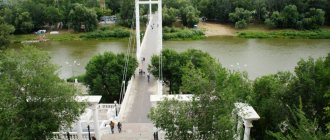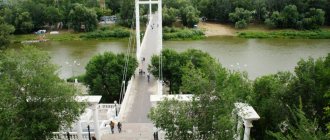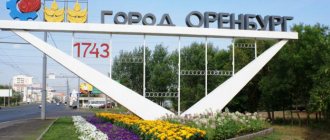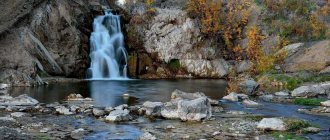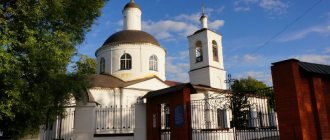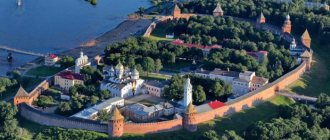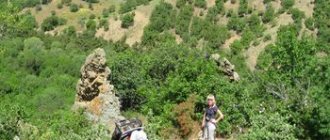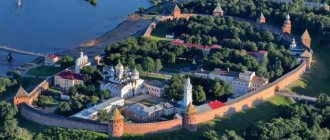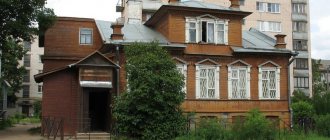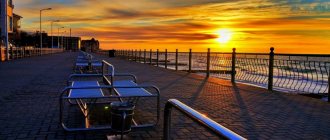Orenburg is one of the cities located on the border of Europe and Asia. Its construction was necessary to open and control roads to Asia.
The location of the fortress city was chosen three times. They even said about this city that it was conceived three times and born once. Finally, in 1743, the Orenburg expedition led by the economist and geographer V.N. Tatishchev , representative of the St. Petersburg Academy of Sciences P.I. Rychkalov and Admiral I.I. Neplyueva founded the city on Red Mountain near the confluence of the Yaik River and the Sakmara River . But its name was given from the Or River , with which the first construction site of the city was connected.
Before we set off to explore the city, we need to go to the Orenburg tourist information center . It is located on Sovetskaya Street 27. The 8 best objects for excursion are indicated there and interesting information about them is given. When visiting these attractions, put elegant stamps in your passport! Vladimir Bobrov worked on them . All the stamps turned out completely different! If you fill out your passport completely, you can receive a gift at the tourist information center! And at the end of the trip you will understand that the passport is the traveler’s real trophy!
What 17 attractions of Orenburg would be interesting to visit in one day?
Cable car
In 2006, a cable car was opened Orenburg , which makes it possible to travel from Europe to Asia . Its length is 233 meters. Passengers travel in cozy translucent cabins. This project even took the status of “The most comfortable cable car in Russia” . The speed of your movement through the air will be 3 m/s, so during the flight passengers have time to take pictures of the river, bridge and embankment from a height of 70 meters.
Elizabeth Gate
The symbolic gate opens the way to Asia. A beautiful building appeared in Orenburg at the request of the Empress in 1755.
For a long time, residents of Orenburg believe that a pedestrian bridge across the Urals connects Europe and Asia. In fact, Orenburg lies in the European part of Russia.
Since 1959, the International Geographical Union has not recognized the border between parts of the world passing through the territory of the city. However, the Europe-Asia stele still stands on the pedestrian bridge.
Visit the Orenburg Down Shawl Museum. Here is the largest collection of famous creations by local knitters in Russia. For many Russians, it will be a revelation to know that the works of craftswoman Maginur Khusainova are stored in museums not only in Russia, but also in Malaysia and Japan.
Address: st. Volodarsky, 13.
Connoisseurs of beauty should visit the art gallery on the street. Shevchenko, 28 and city theaters. You can have a great rest in Perovsky Park in the area of Postnikova Street. Another wonderful place for active recreation and entertainment is Poplar Park near the center of Orenburg.
Toy railway
It just seems like the little train and fairytale stations are made for children. In Orenburg, the Children's Railway is the most adult attraction! The road was built not only for skiing, but also to transport parents to country health camps. The railway line runs along the Ural River . Very picturesque landscapes alternate with brightly decorated stations. I recommend everyone to take a ride, not just tourists with children.
Museum of Orenburg History
The Orenburg History Museum is located next to the cable car . It is easy to see as the building resembles a castle. The tower and the clock on it look especially impressive. It was built in 1856 to house the city treasury and archives. Later his purpose changes. Until 1974, the building housed a guardhouse. The museum examines a variety of topics from the life of the city from its construction to the present day.
But the most interesting room tells about the life of A.S. Pushkin in Orenburg . He became the first researcher on the topic of the Pugachev movement and the Peasant War of 1773-1775 . For this, the poet comes to the Southern Urals . He visited nearby villages and talked with those who witnessed those events. Here he came up with the idea of writing The Captain's Daughter .
Church of St. John the Evangelist
It is impossible not to notice the beautiful temple on Grigorievskaya Street. Red brick walls, green domes, well-groomed territory around - the temple makes an impression on believers of Orenburg and tourists.
The church was erected in 1902. In the first years after its construction, it housed a women's parochial school. The school has now been moved to another building.
Elizabeth Gate
While walking along the embankment, go to the Elizabeth Gate . This is one of the symbols of the city! The history of their appearance is connected with the Bashkir uprisings in the Orenburg lands in 1755. Then the governor of Orenburg I.I. Neplyuev heroically suppressed the Bashkir uprising. In memory of this, Empress Elizabeth gives a gate , which she orders to be installed at the exit from the city, towards the steppes, so that all nomads remember the power of the Russian army . Over time, the gate collapsed. Their fragments can be viewed in the local history museum . And in 2008, a copy of them was installed on the embankment.
Main attractions: what to see, where to go as a tourist
When creating a tour route around Orenburg, include interesting places that can be seen in the city.
Tower with chimes
The tall red brick tower with its chimes resembles a Lutheran church. It was built in the mid-1980s. in honor of the 250th anniversary of Orenburg. The top of the tower is crowned with a spire with a weather vane in the shape of a bird with outstretched wings.
The chime tower was built in honor of the 250th anniversary of Orenburg.
The building has 12 bells that can play 5 melodies. You can hear their ringing every day at 12:00 and 17:00.
While the melody is playing, a window opens under the chimes, in which figures of historical figures who previously lived in the city appear.
St. Nicholas Cathedral
The stone Cathedral of St. Nicholas the Wonderworker was founded in 1883. After that, the temple was rebuilt several times, as a result of which it turned from a single-altar into a four-altared one. In recent decades, it has acquired a new bell tower, chapel and baptismal sanctuary.
St. Nicholas Cathedral was founded in 1883.
Inside the church there is an iconostasis in the late Empire style. Its main shrine is the Tabyn Icon of the Mother of God.
Water tower
The 28-meter round tower in the classicist style was erected in 1929 to supply the city with water. It was designed by local architect I. Ryangin.
You will also like: Top 10 most beautiful and interesting places in the city of Saki
The building was used for its intended purpose until the 1960s, then it was reconstructed.
The water tower is 28 meters high.
Today the tower functions as an office center, but has not lost its former charm.
Holy Trinity Church
The Orthodox Church of the Life-Giving Trinity is located on the territory of the hospital. Pirogov. It was built in 2008 according to the design of A. Gonoshilin.
Holy Trinity Church is an Orthodox church.
The brick church with white walls and gilded domes was built in the old Novgorod style, so it gives the impression that it is old.
It is based on a quadrangle, on the sides of which there are facades with keeled vaults. At the top of the temple there is an asymmetrical bell tower.
Kazan Cathedral
The Temple of the Kazan Icon of the Mother of God appeared in Orenburg in 2001. It was built to replace the old Kazan Cathedral, built in 1894 and destroyed by the Bolsheviks in the 1930s.
Kazan Cathedral is a red brick building.
The modern cathedral is a majestic 2-tier building 55 m high, built of red brick taking into account ancient Russian traditions. It has 4 limits and 17 gilded domes, the largest of which weighs 16 tons.
The maximum capacity of the temple is 2 thousand people.
City Garden named after. Frunze
The park connects the city center with the Rent district. Its main attraction is the “Salute, Victory!” memorial complex.
On its territory there are various types of Soviet military equipment from the Second World War, including:
- anti-tank rifles;
- tanks;
- mortars;
- Voevoda intercontinental ballistic missile (weight – 211 tons, length – 34 m).
City Garden named after.
Frunze contains different types of Soviet military equipment. The organizers of the exhibition did not forget about the rear workers: in the garden you can see agricultural equipment from the war years, as well as a steam locomotive that delivered ammunition to the front.
The memorial complex ends with the Eternal Flame, to which a beautifully decorated alley leads.
Elizabeth Gate
The famous sights of Orenburg include the Elizabeth (Water) Gate. They are a copy of the destroyed gates that Empress Elizabeth granted to the city in the mid-18th century.
Elizabeth Gate is a famous landmark.
The new structure was inaugurated in 2008. It consists of 2 stone columns with niches, inside of which figures of angels are installed. The columns are connected by a horizontal crossbar. In the center of it is a bas-relief decorated with the coat of arms of the Russian Empire with the initials of Elizabeth.
Sovetskaya Street
The most beautiful street in Orenburg stretches through the city center and connects the banks of the Urals with Belovka.
You will also like: Top 10 must-see places to visit in the city of Lomonosov
During your walk, pay attention to the buildings located here, because most of them are associated with some historical figures or events. Its main attractions:
- Higher Military School, where Yuri Gagarin studied;
- Museum-guardhouse of T. Shevchenko;
- the estates of Yenikutsev and Chistozvonov;
- Gostiny Dvor;
- building of the Noble Assembly, etc.
Sovetskaya Street stretches through the city center.
Half of the street is occupied by a pedestrian zone with squares, fountains and unusual installations.
Pushkinsky Boulevard
Sovetskaya Street on one side adjoins Belovka, or Pushkinsky Boulevard. This place is interesting because there was once a fortress here, from which the history of the city began.
Pushkinsky Boulevard adjoins Sovetskaya Street.
It’s worth coming to the boulevard to see the Elizabeth Gate. Next to them is a monument to test pilot V. Chkalov. The observation deck located behind it offers views of the Ural River and the Trans-Ural Grove.
Orenburg embankment
Tourists who are looking for beautiful places to take a photo as a souvenir should go to the Orenburg embankment. Recently, areas for sports with paths and exercise equipment have appeared on it. There is also a small children's railway station located here.
The Orenburg embankment is a beautiful place.
But the most famous place on the embankment is the bridge, symbolically connecting Europe with Asia. It’s nice to walk along it in the evening in good weather and admire the Urals.
National village
The Urals is a region where more than 100 nationalities live. Each has its own traditions and values. You can learn about them in the National Village , where the farmsteads of the 10 most numerous peoples living in Orenburg and the region . Here you can get acquainted with Tatar, Bashkir, Kazakh, Russian, Georgian and other cultures. Through cuisine, literature, crafts and everyday life, you will notice the commonalities and differences between the represented peoples.
Shawl Museum
The down scarf began to be made in the Orenburg province around the 18th century. The museum displays historical exhibits telling about the emergence and development of this craft. You will experience delight and surprise, because this is a real miracle! A scarf created using ancient technologies can pass through a wedding ring! The secret of its softness and strength is the special fluff provided by local goats. The excursion will be interesting for tourists of any age.
Gallery "Orenburg downy scarf"
Gallery "Orenburg downy scarf"
Orenburg
The Orenburg down scarf is one of the main symbols of the Orenburg region. The down knitting industry originated here in the 18th century. The Orenburg Down Shawl gallery was opened in the city in 2012.
The gallery introduces the world's only collection of Orenburg down scarf - talks about the history of artistic craft, fashion and the attributes of folk and urban women's costume. Here you can see ancient tools of craftswomen - spinning wheels, spindles, combs for combing goat fluff. The oldest exhibit is an openwork cobweb from the beginning of the 20th century, which was donated to the museum by the Butovsky family. The weight of the product is only 40 grams.
Victory Park
In summer in Orenburg it is pleasant to walk around the city. It pleases with greenery and fountains. It can even be a pity to waste time on museums. In this case, I recommend visiting an open-air exhibition of military equipment. It is located in Victory Park . Here you can see tanks, planes, self-propelled guns and even trains. The exposition plays out in a very interesting way. You can climb in the trenches, climb onto a train or sit on a cart. Everywhere there are information signs telling about the exhibit.
Museum of Taras Shevchenko
For the 175th anniversary of Orenburg, a museum-guardhouse was opened . Taras Shevchenko was arrested here . The museum is small, but quite realistically reflects the gloomy spirit of the prison premises of the 19th century. There are thick bars on the windows, small cold cells, sparse furnishings.
The formidable guards (wax figures) add realism to the guardhouse. One of the rooms displays the artist’s personal belongings. Museum workers say that Taras Shevchenko violated the emperor’s ban on painting, as he had to devote all his time to military affairs. This is why he ends up here. And even influential friends could not help him. In addition to the permanent exhibition, the museum organizes temporary exhibitions. Most often these are paintings by local artists.
Church of Dmitry Slunsky
The ancient temple, built in the 19th century, was closed during the years of Soviet power and converted into a cinema. The original painting and the faces of the saints were painted over.
The building was returned to the jurisdiction of the diocese only in 1990. Restoration work lasted two decades. The artists managed to recreate an ancient wall painting. The temple looks elegant and solemn.
Address: st. Popova, 98.
House-Museum of the Gagarins
In 1961, Yuri Gagarin flew into space. This was an important event for all humanity. It became especially important for Orenburg , where Gagarin lived for many years. Here he graduated from flight school and found a family in the same city. In the center of the city there is an old merchant mansion, which once housed the Gagarin family , and since 2001 a memorial house-museum . Initially, this was the apartment of Valentina Goryacheva (Gagarina) , but when she married Yuri , the couple lived here for a long time. After moving to Star City , Yuri and Valentina Gagarin periodically visited Orenburg and stayed in this apartment. Most of the items belonged to the astronaut's family, and photographs from the family archive are also presented.
Gostiny Dvor
In the city center between Kirov and Pushkin streets, 9 January and Sovetskaya streets there are long shopping rows. Johann Werner Müller designed the structure in the mid-18th century.
Inside the Gostiny Dvor there were shopping arcades and barns of products brought by merchants and peasants. A watchtower still stands above the gate on the western side. The remains of four bastions are visible.
Space Museum
The Museum of Cosmonautics is located in the flight school where famous pilots of the country trained: Yu. Gagarin , V. Lebedev , Yu. Lonchakov and others. For a long time, the largest exhibit of the museum stood in front of the building - the MiG-15 aircraft Yuri Gagarin flew in 1961 . The school recently celebrated its 95th anniversary. Over its history, it has trained 28 thousand pilots and navigators. Of these, there were 252 Heroes of the Soviet Union, 10 twice Heroes of the Soviet Union and 4 cosmonauts!
The pilots of this school were the first in history to master the skies over the Arctic and Antarctic . In 1963, the first cosmonaut school in the Soviet Union . And then the cosmonautics museum . Part of the collection included personal belongings of Yu. Gagarin and his flight log.
In 1993, the school was disbanded. Within these walls is located the cadet flight school, the first stage of training. The local residents gave the educational institution a funny name: among themselves they call it “letka.”
Europe-Asia Stele
In 1981, column was installed the Ural River , which can conditionally be considered the Europe-Asia border . Why conditional? You know that scientists do not stop in their research. Once upon a time, in the 18th century, it was believed that the Ural River was a natural border dividing the mainland. But everything changed in the 20th century! Today, geographers have determined that the border runs along a mountain range, a little further from Orenburg .
But in memory of the worldview of the past, a stele was erected. It is visible from the ring road and many city guests entering Orenburg stop in their cars near this sign. From the city center, the stele can be easily reached on foot if you move along the embankment. The area near the obelisk is decorated with flower beds and lanterns. You can come here both during the day and in the evening.
TOP 7 graffiti of Orenburg: best locations for photos
The art of graffiti continues to actively develop in Orenburg. As part of various street art festivals, young artists paint the facades of houses and the walls of concrete fences. Through their works, graffists express gratitude to doctors, firefighters, and honor the memory of famous musical performers. Ural56 compiled the TOP 7 graffiti in Orenburg, which are definitely worth seeing. This is a small selection of locations where you can get stylish photos.
Wall of memory of rapper Decl
Wall of memory of rapper Decl, trans. Kashirina, 14
The author of the largest graffiti in Orenburg was an artist from Sterlitamak, Maxim Timirbulatov. In 2021, the city’s department of urban planning and land relations gave permission to fans of Kirill Tolmatsky to decorate the walls of one of the buildings in the regional center. In August 2021, the airbrush artist began work. The graffiti is located on an area of 100 square meters, the cost of the image is about 65 thousand rubles. Fans of Kirill Tolmatsky themselves collected funds for the implementation of this project. On the wall, in addition to the portrait, there is a sign of the Rastamafia group, symbolizing open creativity, and lines from his song are quoted. You can see the image of the famous rapper at Kashirina Lane, 14.
"Heroes of Our Time"
"Heroes of our time", st. Rybakovskaya, 100v.
The graffiti “Heroes of Our Time” appeared in Orenburg on Rybakovskaya Street on the wall of the trolleybus depot building. The author of the image is student of Orenburg State College, volunteer of the volunteer center Daniil Erosko. It was he who represented the Orenburg region at the street art festival of the Volga Federal District “FormART”, dedicated to the fight against COVID-19. As the author himself notes, the graffiti dedicated to doctors is his first large-scale work. To turn his idea into reality, he needed 30 liters of aerosol paint and the help of fellow volunteers.
XXXTentacion graffiti
Graffiti depicting famous rapper XXXTentacion, st. Red Square
Graffiti depicting the famous rapper Jahseh Dwayne Onfroy, under the pseudonym XXXTentacion, appeared in Orenburg back in 2021. Its author was an artist from the art group Artgraffica56. A portrait in memory of the murdered rap artist appeared on Red Square. As the author himself noted, the idea to create such graffiti came to him together with a client who is a fan of the rapper’s work. According to the author’s idea, on the wall, in addition to the portrait, a line from one of the performer’s songs was added.
Over the three years of its existence, the image of Jahseh Dwayne Onfroy has undergone a transformation. Apparently local “artists” decided to form their own vision of modern graffiti. Now the image of the famous rapper looks like this.
Graffiti depicting the famous rapper is also a favorite spot for photographers.
Parking on the street Red Square is the main place where graffiti is concentrated. Here the walls are covered with both festival and unauthorized drawings. Graffiti here is painted one on top of another, without being shy in expressions and artistic means. This is how a mythical culture, educational, alien, is presented here; there is even a vision of the painting “The Creation of Adam”.
Graffiti depicted on the walls of the parking lot on the street. Red Square
Retro graffiti
Retro graffiti on the territory of the central market
There is unusual retro graffiti on the territory of the central market. The author of the historical drawing on the wall of the Megapolis shopping center was Anna Dryganova, the muralist timed her work to coincide with the 140th anniversary of the central market. Retro-style graffiti is made in the form of a collage of photographs from different eras, both the Soviet and Tsarist periods. Anna Dryganova worked for a month to create this image, and the artist Dmitry Sumbaev also helped her.
Graffiti to firefighters
Graffiti depicted on the facade of the crisis management center building, st. Gaya, 21
Orenburg graffist Daniil Mishchenko created his art object for the 30th anniversary of the Main Directorate of the Ministry of Emergency Situations of Russia in the Orenburg region. The image is located on the facade of the crisis management center building on the street. Gaya, 21. As the artist himself notes, in his composition he reflected not only the fire service, but also rescuers who interact with each other. The figure shows a total area of 100 sq. meters Daniil Mishchenko also depicted emergency numbers. It took the artist only 2 weeks to create the graffiti.
Einstein-Rosen Bridge
"Einstein-Rosen Bridge", st. Eastern, 29
From September 2021 on the facade of a nine-story building on the street. Vostochnaya, 29 is decorated with graffiti “Einstein-Rosen Bridge”, dedicated to the 275th anniversary of Orenburg. The art object appeared as part of the largest Russian festival of street art and graffiti “Stenography”. The drawing is about 300 square meters. meters was depicted by the Ekaterinburg team Stenografia. The art object is named after the astrophysical phenomenon “Einstein-Rosen Bridge”, connecting two universes.
Mr. Baron
Mr. Baron, st. Gagarin Avenue, 21/8
The selection of TOP 7 graffiti of Orenburg is completed by the cat Baron. The author of this drawing is Orenburg artist, graffist Dmitry Sumbaev. He decided to paint a portrait of his cat on the wall of one of the garages in the courtyard of the house on the street. Gagarin Avenue 21/8. As the residents themselves note, with the appearance of Mr. Baron, Donkovtsev Street has become much more comfortable.
Caravanserai
Typically, a building with this name is intended to accommodate traders with goods. But in Orenburg this complex of buildings was provided for the comfort of the Bashkir military. The fact is that at the beginning of the 19th century, the governor of the Orenburg region decided to create a powerful military force. It included Bashkir military and Ural Cossacks.
As a step of respect for the religion of the Bashkirs, a mosque was built. Construction was carried out at the expense of the city budget, but the Muslims themselves helped prepare the materials. From 1837 to 1846, the complex was built under the leadership of Alexander Bryullov (brother of the famous artist Karl Bryullov ). It consisted of a mosque, a two-story building where the commander of the Bashkir army , a military office and various workshops. From 1865 to 1917 this building became the residence of the Orenburg Governor .
Planetarium
The Orenburg Planetarium is 65 years old. It was the eighth planetarium in the country. Initially, during Soviet times, it was located in the building of the Caravanserai , and in the 1980s it was allocated another building.
From the very first minutes, visitors are immersed in the cosmic world. The hall where events take place is brightly decorated. Planets and various spacecraft are located under the ceiling. The windows also display children's works on space themes. The planetarium offers programs for both children and adults. Most of them take place in the form of lectures and films. Equipment with a rotating dome immerses the viewer in outer space. But if you want to watch a real solar eclipse, you will be asked to go to another room where a powerful telescope is installed. It can easily “deliver” you to the rings of Saturn or to the Milky Way .
Museum of Fine Arts
The Museum of Fine Arts consists of two buildings. The old building, classical style, was built in the 19th century by Mikhail Malakhov . It was intended for the city council and court. During Soviet times, a kindergarten was located here. The second building is modern, transferred to the museum’s collections in 2012.
For those who are interested in the fine arts of our country, visiting the museum will make many discoveries for themselves. Most of the collection is focused on the preservation and development of national culture. Part of the fund is occupied by works by Orenburg artists, as well as decorative and applied art of the Southern Urals .
Water tower
Looking at this structure, it’s hard to believe that the building is more than a hundred years old. In 1904, at the intersection of modern Pobeda and Zhukov avenues, a revolutionary structure for those times was built.
The tower was intended for water purification. The useful volume was about 80 buckets. The water tower was the first step towards the rapid development of the city.
The architectural monument has been restored and makes a good impression. The building is located on the street. Gorky, 57.
Orenburg Governor's Museum
The appearance of this museum is due to the Orenburg military governor P.P. Sukhtelen . In the middle of the 19th century, he gathers representatives of the scientific world and sets before them the task of systematizing knowledge about the Southern Urals . By this time, the Orenburg region was poorly studied, all materials were scattered. It was supposed to unite them and create a regional museum telling about the botany, geology and zoology of the region.
Among the scientists was V.I. Dahl . He is appointed to the position of corresponding member of the St. Petersburg Academy of Sciences . His tasks included studying the flora and fauna of the Orenburg region . Having lived for almost 10 years in the Southern Urals , he wrote the first textbooks in Russia on zoology and botany. , a “zoological museum” was formed in Orenburg , which laid the foundation for the local history museum . Today, its collection includes more than 100 thousand exhibits. Among them are works of craftsmen of the region, household items, costumes, musical instruments...
Orenburg
The face of any city is unique. It is created not only by architectural buildings, parks, squares, but also by historical and cultural monuments that depict events, statesmen, people of science, literature and art, as well as urban sculpture, which is now widely represented. All this is available in Orenburg. I will introduce some of them.
Let's start with the park named after. Osipenko. A Stele was installed here in honor of the founding of Orenburg in 1743. Its author is V. M. Kuznetsov. Carved on the granite in Slavic script: “Orenburg was founded in 1743.”
Liked!
3
3
Author: Nina__Pastuhova
In the same park there is also a monument to A.S. Pushkin and V.I. I will. Sculptor N. Petina. Installed in 1998 to perpetuate the fact that A. S. Pushkin and V. I. Dahl, great representatives of Russian literature, were in Orenburg.
Liked!
6
6
Author: Nina__Pastuhova
Another monument to Pushkin was erected near the building of the former Guardhouse. Installed in 1977. Made of bronze and concrete. The height of the figure is 2.92 m. Sculptor V. S. Stepanyan. While working on “The History of Pugachev,” A. S. Pushkin visited Orenburg (September 1833). In this regard, the idea of a monumental perpetuation of this event repeatedly arose in Orenburg. At the beginning of 1977, sculptor V. S. Stepanyan offered his services to create any monument. The sculpture was commissioned from him. The monument is located on the banks of the Urals. The choice of location was due to the fact that Pushkin, whose guide was V. I. Dal, loved to visit the Ural embankment.
Liked!
4
4
Author: Nina__Pastuhova
Here on the embankment there is a monument to V.P. Chkalov. On November 7, 1953, when the whole country celebrated the 36th anniversary of the Great October Socialist Revolution, on the high bank of the Urals, near the Military Aviation School of Pilots, a monument to the outstanding pilot of our time Valery Pavlovich Chkalov was unveiled. Valery Chkalov was a graduate of the military aviation school, which settled in Orenburg in the thirties. Even before the erection of the monument, his name was inscribed in the history of the city - from 1938 to 1957 Orenburg was called Chkalov.
Liked!
2
2
Author: Nina__Pastuhova
After the death of V.P. Chkalov On December 15, 1938, a decree of the Council of People's Commissars of the USSR was issued, which spoke about perpetuating the memory of Chkalov. The sculptor I. A. Mendelevich created two monuments. One was installed in Gorky (Nizhny Novgorod) in 1940, and the second should be installed on the square of the Kursk station. But the chief architect of the city, Chichulin, said that it is impossible to erect such a large monument, the head of which is higher than the station building. There is another version - Comrade Stalin, puffing on his pipe, literally said the following: “I personally know Comrade Chkalov, so it’s not him.” And this monument was erected in Orenburg after the war.
Liked!
0
0
Author: Nina__Pastuhova
photo from the Internet The six-meter bronze sculpture on a seven-meter pedestal is clearly visible from Sovetskaya Street, Naberezhnaya Street and from the park named after V.P. Chkalov. The author of the monument, sculptor I. A. Mendelevich, depicted V. P. Chkalov after he completed his responsible flight.
Ivan Ivanovich Neplyuev is the founder of Orenburg and the first Orenburg governor. During the years of his reign, he did a lot for the city. He equipped schools, hospitals, built churches. He also took care of the rise of industry in the province. A bust of Ivan Ivanovich Neplyuev was installed on Sovetskaya Street in 1994 on the occasion of the 300th anniversary of his birth.
Liked!
2
2
Author: Nina__Pastuhova
The monument, with a total height of about 3 m, is a bust standing on a high pedestal in the form of a column. The inscription on the pedestal reads: “Founder of Orenburg I.I. Neplyuev 1693-1773.” Authors: sculptor N. G. Petina, architects P. G. Kantaev and A. A. Yankin.
Liked!
1
1
Author: Nina__Pastuhova
Soon the monument will be complemented by a colonnade with two bronze plaques: the first will depict the milestones of the city’s development, the second will depict the biography and achievements of Neplyuev himself. In the meantime, this is the wall.
Liked!
0
0
Author: Nina__Pastuhova
A small, elegant Leninsky Square is located on Sovetskaya Street in the center of Orenburg.
Liked!
3
3
Author: Nina__Pastuhova
It has existed since 1863 as the Alexander Garden. The garden has a rectangular shape and is surrounded by a low metal fence. The following trees grow here: small-leaved elm, ash-leaved maple, balsam poplar, common ash, Siberian apple tree, white acacia, small-leaved linden, pedunculate oak. Shrub: common lilac, serviceberry, brilliant cotoneaster, yellow acacia. My photos were taken in winter, so I’m bringing photos from the Internet. The name of the square is confirmed by the rather interesting monument to Lenin installed in its center.
Liked!
3
3
Author: Nina__Pastuhova
Firstly, this is one of the first monuments to Lenin in the country, created shortly after his death and inaugurated on May 1, 1925. The bronze figure was cast in Leningrad, in the workshop of the art and industrial technical school. Secondly, the monument was erected with money raised by the people. They say that they collected them for a hydroelectric power station on the Sakmara River, but they could not collect the required amount and it was decided to decorate the city with a monument instead.
Liked!
3
3
Author: Nina__Pastuhova
Thirdly, this is perhaps one of the smallest monuments to Lenin in Russia; the creators of the monument, sculptor Kozlov and architect Ryangin, decided to depict the leader in life-size - the height of the monument is only 165 centimeters. The idea turned out to be controversial; the monument raised on a pedestal looks very small. The monument is made in a traditional manner, Lenin is depicted addressing the audience with a speech.
Another interesting small architectural form in the park is a small rotunda gazebo installed in its southern part. Built in the style of classicism, the elegant white gazebo was most likely built in 1829 in the Trans-Ural Grove during the reign of military governor P.K. Essen, who had a passion for gardens and parks, according to the design of the architect Alfeev.
Liked!
5
5
Author: Nina__Pastuhova
It was moved to the park at the end of the 19th century. In its center there is a former fountain sculpture depicting a girl with a jug and children.
Liked!
4
4
Author: Nina__Pastuhova
Not far from the square there is a monument to the first teacher. Each of us had our own, unique one. And no matter how old she is, for most she remains in the memory of the kindest and most beautiful. The sculptural composition “The First Teacher” was opened on International Children’s Day.
Liked!
5
5
Author: Nina__Pastuhova
The bronze sculpture of five figures symbolizes the image of the first teacher, to whom four schoolchildren climb the steps of the “ladder of knowledge.” The sculptural composition is the center of the composition, which includes a memorial stele with the names of the best teachers of the Orenburg region. The events that unfolded around this monument before its installation are interesting. At the pre-show, the public gasped - the teacher looked too frivolous. Judging by the sculptural composition, it turns out that the collective image of first-graders was stuck somewhere in Soviet times, and the image of the teacher was borrowed from the pages of men's magazines. The authors had to make some adjustments to the sculpture of the teacher.
Liked!
5
5
Author: Nina__Pastuhova
A nice sculpture is also located on Sovetskaya Street. This is the new symbol of Orenburg - the golden Sarmatian deer. The sculpture is an exact copy of a deer figurine found during excavations at the Filippovsky mounds in the Ilek district of the Orenburg region. The noble animal was sacred to the Scythian-Sarmatians, who inhabited in the 5th–4th centuries BC. e. Orenburg steppes: it was believed that the deer brings good luck, health, strength and protects the love of those who touch it.
Liked!
5
5
Author: Nina__Pastuhova
Now every resident of Orenburg can touch a deer.
At the intersection of Zwilling Street and Park Avenue there is a monument to the victims of the White Guard raid on Orenburg. Behind it is a very nice building.
Liked!
4
4
Author: Nina__Pastuhova
Our regional center has become the twelfth city out of forty participating in the “Good Angel of the World” project, implemented by the International Charitable Foundation “Patrons of the Century”. At the corner of Postnikova Street and Park Avenue in the park named after April 4, it was opened in 2008. architectural and sculptural composition “Good Angel of Peace”.
Liked!
2
2
Author: Nina__Pastuhova
The composition represents a figure of a three-meter-tall golden guardian angel with a dove in his hands, on a six-meter-tall tetrahedral column. The angel walking on the hemisphere personifies the Earth, and the dove in his hands is a symbol of Peace and Hope. The entire structure is supported by a square pedestal about three meters high, with text carved on all four sides. On the front side there is quite a voluminous text telling about the composition itself. The names of the authors of the artistic concept of the complex are also carved here - these are O.V. Oleynik, President of the International Union of Charitable Organizations “World of Good” and P.T. Stronsky, President of the International Academy of Culture and Art.
Liked!
1
1
Author: Nina__Pastuhova
On the back side of the pedestal under the title “Orenburg Patrons of the Centuries” are the names of philanthropists of the past. On the sides of the base are words of gratitude for financial support, assistance in the construction and creation of the complex with a list of organizations, institutions and names of individuals.
Liked!
1
1
Author: Nina__Pastuhova
In front of the pedestal is a stylized image in the form of an open book with the inscription: “Golden Book of Nations.” List of cities where such a composition is also installed.
Liked!
0
0
Author: Nina__Pastuhova
In the same park there is a monument to Musa Jalil. Installed in 1996 to mark the 90th anniversary of the poet’s birth. The author is Kazan sculptor Kadym Zalitov. His childhood and youth are closely connected with Orenburg. The monument appeared thanks to the efforts of the government of Tatarstan, the administration of Kazan and Orenburg, and donations from people of different nationalities. The monument was cast in Tataria, the weight of the sculpture is about 1.5 tons. At school we studied the works of the poet.
I also included this original building, located at the intersection of Pobeda and Zhukov avenues, as a monument. It is a historical landmark of the city. The building, created to purify water in the city, with a capacity of just over eighty buckets, began operating in 1904.
Liked!
3
3
Author: Nina__Pastuhova
But the scientist and researcher of the Orenburg province Pyotr Rychkov meets and sees off the residents and guests of the city. Along with Governor Ivan Ivanovich Neplyuev, Rychkov was the initiator of the creation of the Orenburg province. But his companions called him not only the founder, but also the singer of these places. A monument to him was erected on the station square.
Liked!
4
4
Author: Nina__Pastuhova
As they say, “The theater begins with a coat rack, and the city begins with a station.” The station in Orenburg is one of the most beautiful in our area. It was made in the spirit of St. Petersburg architecture. It was opened on December 31, 1876.
Liked!
4
4
Author: Nina__Pastuhova
As you can see, the monuments in the city were mostly erected recently, but that’s good news! The city remembers, lives, develops!
Chip flights
Find a hotel
